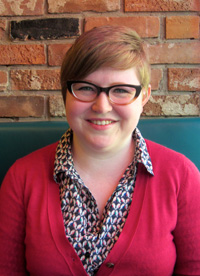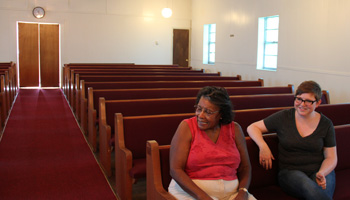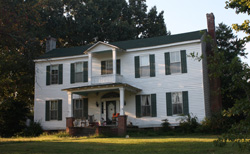Abigail Gautreau: PhD Candidate
What led you to your field? I came to historic preservation in a very roundabout way. In my previous work as a historian, I studied French history with a particular focus on the French Revolution. Like many young people unfortunate enough to graduate into the Great Recession, I held a number of jobs but struggled to find a career. I taught English and history at a local high school, and after I completed my Master’s, I taught history at a community college. I enjoyed teaching immensely, but I was ready for a change of scenery. At the time, I was aware that there were historians who worked outside of universities, but I was unsure how to translate my academic background into something more practical. I then found a great fit when I discovered the Public History PhD program at Middle Tennessee State University. I met with Dr. Carroll Van West, who would become my dissertation chair, and I started in January 2011 with an assistantship at the Center for Historic Preservation. Historic preservation was a great fit for me because it allowed me to use my research skills on real-life products that provided tangible benefits to communities.
I came to historic preservation in a very roundabout way. In my previous work as a historian, I studied French history with a particular focus on the French Revolution. Like many young people unfortunate enough to graduate into the Great Recession, I held a number of jobs but struggled to find a career. I taught English and history at a local high school, and after I completed my Master’s, I taught history at a community college. I enjoyed teaching immensely, but I was ready for a change of scenery. At the time, I was aware that there were historians who worked outside of universities, but I was unsure how to translate my academic background into something more practical. I then found a great fit when I discovered the Public History PhD program at Middle Tennessee State University. I met with Dr. Carroll Van West, who would become my dissertation chair, and I started in January 2011 with an assistantship at the Center for Historic Preservation. Historic preservation was a great fit for me because it allowed me to use my research skills on real-life products that provided tangible benefits to communities.
How does what you do relate to historic preservation?
As a graduate student assistant at the Center for Historic Preservation, I have worked on a variety of projects that all fall under the umbrella of historic preservation: National Register nominations, architectural surveys, historic structure reports, interpretive plans, and lesson plans. While some of these projects, like survey work and National Register nominations, are obvious historic preservation projects, I consider my interpretive work to be just as relevant to historic preservation. Saving historic buildings and sites is incredibly important, but preservationists need to be willing to take that next step and help communities make the places they’ve saved relevant and useful.
Why do you think historic preservation matters?
Historic preservation matters because it protects the physical places where history happened and allows us to connect in a real and tangible way with the past. It’s one thing to know that Martin Luther King, Jr. gave powerful speeches, but to be in Selma, Alabama, at First Baptist Church and imagine the entire building overflowing with people listening to hear him speak is meaningful in a way that is difficult to put into words. The built environment transforms the past from something purely intellectual to something profound and visceral. As we march into the future, we need reminders that the past was real, something that happened in color and motion to people not unlike ourselves.
 Historic preservation is also important because it can help us see the places we live differently. The built environment can outlast social and political events. Where I live in Murfreesboro, Tennessee, for example, there are several blocks of large, fine homes with ample yards near the town square lining Main Street. One block over, the houses are much more modest and built on smaller lots. This is because the smaller houses were built for the mostly African American families who did domestic work for the white families in the larger homes on Main Street, so that they would be nearby. While these types of arrangements are much rarer nowadays, the legacy of that time is embedded in the landscape.
Historic preservation is also important because it can help us see the places we live differently. The built environment can outlast social and political events. Where I live in Murfreesboro, Tennessee, for example, there are several blocks of large, fine homes with ample yards near the town square lining Main Street. One block over, the houses are much more modest and built on smaller lots. This is because the smaller houses were built for the mostly African American families who did domestic work for the white families in the larger homes on Main Street, so that they would be nearby. While these types of arrangements are much rarer nowadays, the legacy of that time is embedded in the landscape.
More than anything else, however, I think historic preservation matters because it empowers communities and individuals to take care of the places that matter to them.
What courses do you recommend for students interested in this field?
I would encourage students interested in historic preservation to consider courses in the field, of course, but I would also suggest exploring related fields like material culture and oral history. There are many different types of historic preservation programs out there; some focus on architecture and planning, others on history, and still others concentrate on the physical work of preservation itself. There is no wrong approach to doing preservation, so find something you enjoy and keep an open mind about how other approaches can help expand your horizons as a preservationist.
Do you have a favorite preservation project? What about it made it special?

I am reluctant to say that I have a favorite project, since it always seems to be the one I am working on right now, but a project that will always have a special place for me is my nomination of Oak Hill Farm in Tipton and Haywood counties in West Tennessee. Oak Hill Farm is a Tennessee Century Farm, meaning it has been in continuous operation by the same family for more than 100 years. The farm began its life as a cotton plantation in the 1830s, and still features a beautiful Federal-style frame house that has only seen one major renovation in the 1950s/60s. It became a dairy operation in the 20th century, and today the current residents raise heritage hogs and pursue sustainable farming techniques.
The project is special because it was the first nomination I wrote and completed on my own. I spent a week with the Maclins, living in their home and wading through decades of old papers, photographs, and most memorably, a box of hair. It was definitely not an easy project; I had to teach myself a lot about the history of farming, and I spent a fair amount of time lamenting that no one had written a detailed history of mid-century farming in Tennessee. Despite the occasional frustrations, I was inspired by how much the family cared about the farm, and how hard they worked, and continue to work, to do right by the farm and its legacy.
Can you tell us what you are working on right now?
I am currently in the middle of my year-long PhD professional residency. I have been Lead Investigator for the Center for Historic Preservation’s projects in Selma, Alabama, which means that I have been working with the community in Selma on a series of projects related to the Civil Rights and Voting Rights Movements. The first project was the completion of a Multiple Property Submission (MPS) to the National Register of Historic Places describing the Civil Rights Movement in Selma from 1865 to 1972. Along with my fellow graduate students Jessica French and Amber Clawson, I completed extensive research for the MPS, which was compiled by Dr. Van West and accepted by the Register on June 26, 2013. Now that the MPS is complete, I am working on several individual nominations.
I have also begun an oral history project in Selma. Though the project is still in the early stages, I am humbled by the stories that Selma’s citizens have been willing to share. The people I have interviewed so far were all students during the Movement. Students were on the front lines of the Movement in Selma; they marched for voting rights and tested the desegregation of business after the passage of the Civil Rights Act of 1964. Their activism and willingness to risk their safety and even their lives were key to the success of the Selma Movement. While there is no shortage of books on Selma, very few have engaged with the history of the student activism. I hope that the material that eventually develops from the oral history project will encourage scholars and historians to consider more inclusive narratives about the Selma Movement.
How do you think the national historic preservation programs help your community?
National preservation programs have played a key role in Selma. The grant to fund the completion of the MPS and related nominations came through the Certified Local Government program, which is jointly administered by the State Historic Preservation Office and the National Park Service. The National Register of Historic Places (NR) program has also been tremendously helpful for Selma. Although the goal of nominating properties is to draw attention to them, the Center for Historic Preservation takes the view that the NR work can also create foundational documents for interpretation. We hope that the MPS and the subsequent nominations will help Selma develop new interpretive material for the tourists who stream into the city to learn about its history. While Selma attracts many tourists, the story they learn is often limited to the actions of Dr. King, Bloody Sunday, and the March to Montgomery. Selma’s story is much more complicated than that, and these programs have given Selma the resources to explore different aspects of the story.
The ACHP’s mission is “preserving America’s heritage;” can you give us an example of how your community is preserving their heritage?
One of the things I have enjoyed most since starting to work in preservation is that I now have several communities. Above, I talked about some of the ways people in Selma are preserving their heritage. One of my favorite ways that Murfreesboro celebrates its heritage is through its preservation of the historic town square. Main Street Murfreesboro, which is an affiliate of National Main Street and the National Trust for Historic Preservation, has helped Murfreesboro keep its square lively while preserving much of its historic appearance. Main Street organizes events like JazzFest and the Main Street Saturday Market, a farmers’ market where you can buy everything from local produce (if you get there early enough!) to cakes and pastries. The square is also home to some great locally owned restaurants where you enjoy an amazing meal in a historic former shop or house.
I would also be remiss if I didn’t mention another of my favorite local heritage events, though I don’t know that the organizers really think of it as being a heritage event, per se. Nashville is the original home of hot chicken, a truly delicious local delicacy of spicy fried chicken. Every year on July 4, East Nashville hosts the Music City Hot Chicken Festival. Hot chicken vendors from all over bring their A Game to thousands of visitors, and non-professionals compete in the Amateur Cooking Competition to see who makes the best hot chicken.
One of my favorite things about heritage is that it’s about more than just buildings; heritage is about ways of life, music, and food.
Read more Q&A stories about the preservationists in your neighborhood!